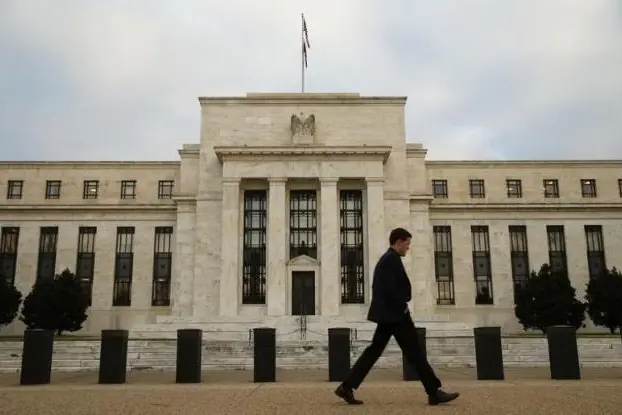PHOTO
(John Kemp is a Reuters market analyst. The views expressed are his own)
LONDON- The U.S. Federal Reserve’s determination to stimulate the economy through low interest rates and bond buying until employment returns to pre-epidemic levels will likely raise commodity prices significantly in the interim.
Production and employment have fallen much further below their long-term trends than prices, as a result of the epidemic, and before that the trade wars with China and other trading partners in 2018/19.
If the central bank is determined to stimulate the economy until the production and employment gaps have been closed fully, it will have to accept a significant overshooting in prices compared to trend.
By targeting parts of the economy that exhibit the most cyclical slack, the central bank must accept that other parts of the economy with far less slack will exhibit significant frictional inflation.
Top officials calculate these price signals will be temporary and will not become embedded into corporate and household expectations and price- and wage-setting behaviour.
If they are correct, wages will experience a one-off fall in real terms. If not, embedded inflation will require more contractionary monetary and fiscal policies in future to stop overheating and bring prices back to target.
FULL EMPLOYMENT
Estimating the amount of cyclical slack in the economy as a result of the epidemic, lockdowns, trade wars and the general business cycle downturn, is more of an art than a science.
Estimates depend on identifying a point in the past when the economy was at full capacity utilisation and employment, an underlying trend growth rate, and then projecting output, employment and prices forward.
The National Bureau of Economic Research’s Business Cycle Dating Committee estimates the last cycle peaked in February 2020, immediately before the first wave of coronavirus infections hit.
Manufacturing output peaked more than a year earlier in December 2018, after which the economy started to be hit by the impact of conflicts with major trading partners and a rise in policy uncertainty.
Sometime from December 2018 to February 2020 is therefore most likely to correspond to full employment and capacity utilisation – when the unemployment rate was around 3% and the utilisation rate was 75-78%.
CYCLICAL DEVIATION
In the five years prior to December 2018, manufacturing output increased at an average annual rate of 1.2%, while the number of nonfarm jobs increased by around 1.8% per year.
By December 2019, production had already fallen 2% below its previous trend, as a result of the trade wars, and the deficit had widened to 22% at the height of the first wave of the epidemic and lockdowns in April 2020.
Since then manufacturing output has rebounded as a result of fiscal and monetary stimulus, as well as the re-opening of much of the economy, and is now just 5% below its 2014-2018 trend.
In the labour market, nonfarm employment is currently 7% below the 2014-2018 trend, with the deficit slightly worse in services (-7%) and construction (-7%) and narrower in manufacturing (-6%).
The loss of employment compared with the previous trend is equivalent to 9 million jobs in services, 800,000 jobs in manufacturing and 600,000 jobs in construction.
Overall, therefore, output and employment are about 5-7% below their pre-epidemic trend and probable potential level, which is the best measure of the gap the Fed is trying to close.
By contrast, downward pressure on prices has been more modest. The personal consumption expenditures price index for all items other than food and energy is less than 1% below its level in December 2018 projected forward at the Fed’s target increase of 2% per year.
On the pricing side, the negative deviation from trend is likely to be closed within the next 3-6 months between July and October.
Negative deviations in production and employment are likely to take much longer to close, depending on relaxation of coronavirus controls and the speed of the business expansion.
CHOOSING A TARGET
The Fed’s dilemma is that it has only one instrument (really a suite of inter-related instruments including short-term interest rates and portfolio adjustments).
With one instrument, it can only have one primary target, a point made by the Dutch economist Jan Tinbergen, and known as the “Tinbergen rule”.
So the Fed must choose between targeting the negative production-employment gap, which implies a longer period of stimulus, or the price gap, which implies a far shorter one.
The Fed’s public explanations of its strategy, articulated in press statements and speeches by policymakers, tend to make confusing remarks about both the production-employment and price gaps.
Top officials talk about the need for prices to catch up after a period of below-target increases, though the target level is unstated, and the evidence for prices being significantly below trend is limited.
By contrast, Fed actions show it is primarily focused on closing the production-employment gap, and prepared to tolerate a degree of overshooting on prices in the meantime.
In reality, the central bank has no choice, given its limited range of policy instruments and the different degrees of slack in different parts of the economy.
But prolonged stimulus through 2021 and into 2022 will ensure the manufacturing supply chain (including raw materials, freight transportation, warehousing and distribution) is stretched taut for at least the next 12-18 months.
Prices for raw materials, transportation and manufactured items will therefore move above long-term trend levels earlier than usual in this business cycle as the Fed tries to mop up remaining pockets of unemployment.
(Editing by Kirsten Donovan) ((john.kemp@thomsonreuters.com))












